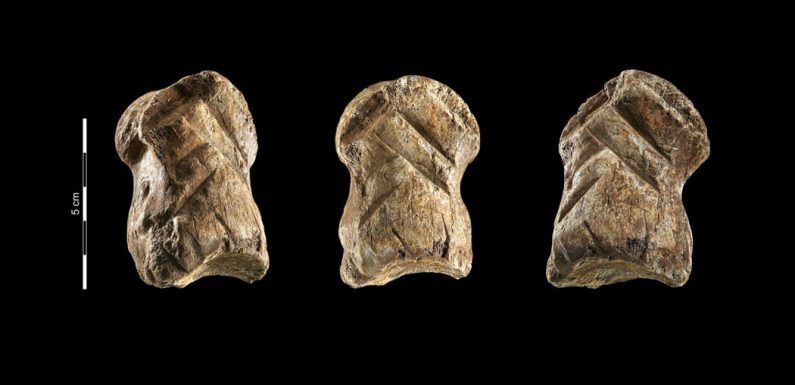
In 2019, a team of archaeologists climbed a steep, rocky hill in central Germany and burrowed inside the collapsed entrance of the Unicorn Cave, named as such because people in the Middle Ages once scoured it for unicorn bones. Today it is famous for its animal fossils.
Over the course of about a month, they excavated an area of just 16 square feet, pulling out of the brown dirt dozens of ancient mammal bones. Most were unremarkable, either the remains of bears who had once used the cave to hibernate, or the butchered castaways from carcasses hunted by Neanderthals tens of thousands of years ago.
But one specimen, a 2-inch-long foot bone of a giant deer, stood apart. It was carved with six thick rectangular notches, in a distinct chevron pattern.
When Thomas Terberger, the project’s leader, first saw those cut marks, he knew they could not have been made by accident. “We realized it was more profound — it was something intentionally carved into the bone surface,” said Dr. Terberger, an archaeologist with the State Service for Cultural Heritage Lower Saxony in Hannover, Germany.
The bone was likely boiled before being carved, and took about an hour and a half to make, Dr. Terberger said. When the bone stands upright, the chevron pattern points to the sky.
Even though Neanderthals were known to have lived in and around the cave, Dr. Terberger initially thought the carving had to have been made by an early Homo sapiens. Such cultural artifacts from Neanderthals are extremely rare, after all, and often contested. But radiocarbon dating showed that the foot was 51,000 years old — meaning it was made several thousands of years before the first early modern humans showed up in the region.
So the carving, as the scientists published this week in Nature Ecology & Evolution, was almost certainly made by Neanderthals. As Silvia Bello, a researcher at the Natural History Museum in London who was not involved in the discovery, wrote in the same issue of the journal, the finding is “one of the most complex artistic expressions by Neanderthals thus far known.”
Ever since the first major Neanderthal fossil was found in another German cave in 1856, our hominin cousins have been thought of as thick, dumb brutes. Although more recent discoveries have shown that Neanderthals used sophisticated tools, buried their dead and, of course, mated with Homo sapiens, “we are still somehow a bit imprisoned in our image of the Neanderthals from the 19th century,” Dr. Terberger said.
The new carving is one of only a handful of examples of Neanderthal art, like body ornaments, rock engravings and notched animal bones. Many scientists have raised doubts about whether some of these Neanderthal art pieces were actually tools, and whether they picked up their creative proclivities from interactions with early ancestors from our species.
The carving was made on the foot of a giant deer, a majestic animal that was rare in the area and may have had symbolic meaning to the people who killed it, Dr. Terberger said.
But is this bone carving with its chevron patterns really art? Dr. Terberger prefers to call it a complex decoration, perhaps a precursor to art. “But they do not make a decoration complex like this just to have fun,” he said.
“The size suggests it’s something you can hold in your hand, look at it and inspire your imagination,” he said. “Everybody can decide for themselves what he sees in this.”
What we’re metabolizing lately
After 18 months of Covid, scientific publishing and peer review may never be the same. Maggie Koerth reports on what scientists are learning from that.
Who gets a kidney transplant? A biracial man’s case shows how assumptions about race play into listings for lifesaving organ donations.
Did Jaws have a BFF? The social lives of sharks have been highlighted in recent years.
China is building a space station in orbit, and a pair of the country’s astronauts took a trip outside for the first spacewalk at the outpost on Saturday.
The nine lives of “Cat Person.” Phew.
Finally, beetles, spiky genitals and “a quite literal girding of the loins.”
Source: Read Full Article